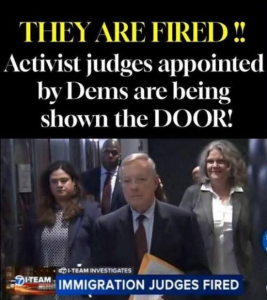
Trump’s Immigration Court Overhaul: Firings, Backlogs, and the Future of Due Process
In a sweeping and controversial move, President Donald Trump’s administration has intensified its efforts to reshape the U.S. immigration system by dismissing dozens of immigration judges, triggering alarm across legal communities and immigrant advocacy groups. This action, part of a broader strategy to tighten immigration enforcement, comes at a time when the immigration court system is already buckling under a record-breaking backlog of nearly 3.7 million cases.
A Sudden Purge of Judges
On February 15, 2025, the Department of Justice (DOJ) abruptly terminated 20 immigration judges, including five assistant chief judges and 13 newly appointed judges who had not yet been sworn in. Two additional judges were dismissed earlier that same week. The firings were executed without public explanation or plans for replacement, leaving many to speculate about the administration’s motives and the long-term implications for the immigration court system.
Among those dismissed was Kerry Doyle, assigned to the Chelmsford, Massachusetts immigration court. Doyle received a termination notice stating her retention was “not in the best interest of the agency,” with no further clarification. The lack of transparency has fueled concerns about politicization and the erosion of judicial independence.
A System on the Brink
The immigration court system, overseen by the DOJ’s Executive Office for Immigration Review (EOIR), has long struggled with underfunding and understaffing. As of early 2025, the backlog of pending cases had surged to 3.7 million, with each judge handling an average of nearly 5,000 cases. This staggering caseload has led to delays of four to five years for hearings, undermining the timely administration of justice and leaving immigrants in prolonged legal limbo.
The firings have exacerbated an already dire situation. Without replacements, the remaining judges face even greater pressure, and immigrants—many of whom are asylum seekers—must wait longer for their day in court. Critics argue that this undermines due process and violates the principle of fair and impartial adjudication.
Strategic Downsizing or Political Maneuver?
The Trump administration’s decision to dismiss judges aligns with its broader agenda of government downsizing and aggressive immigration enforcement. Matthew Biggs, president of the International Federation of Professional & Technical Engineers, confirmed the terminations and described them as part of a larger effort to shrink the federal workforce.
However, many legal experts and immigration advocates view the firings as a calculated move to reshape the courts in favor of expedited deportations. By removing judges who may be perceived as lenient or independent, the administration can install replacements more aligned with its hardline policies—if it chooses to replace them at all.
This strategy echoes Trump’s first term, during which he implemented “get-tough” changes to immigration courts, including limiting judicial discretion and expanding prosecutorial power. In his second term, the administration has doubled down, rolling out restrictive rules and dismantling oversight mechanisms.
Erosion of Safeguards
Beyond the firings, the administration has enacted a series of policy changes that critics say erode protections for immigrants:
- Elimination of free legal counsel for an estimated 26,000 unaccompanied minors.
- Empowering judges to deny asylum claims without hearings, reducing transparency and fairness.
- Closure of ombudsman offices that monitor court operations, detention facilities, and law enforcement conduct.
These changes reflect a broader shift toward enforcement over adjudication. The goal appears to be sweeping more immigrants into the system and accelerating their removal, rather than ensuring fair hearings and legal representation.
ICE Arrests Surge
Outside the courtroom, Immigration and Customs Enforcement (ICE) has ramped up arrests. Nationally, ICE arrests increased by 124% in June 2025 compared to the previous year, with Illinois seeing a 98% spike. This surge adds further strain to the court system, as more detainees require hearings and legal processing.
The imbalance in federal funding compounds the crisis. In fiscal year 2024, Congress allocated $3.43 billion to immigration detention facilities but only $840 million to support the immigration courts. This disparity underscores the administration’s prioritization of enforcement over adjudication.
Legal Community Reacts
Immigration attorneys and judges have expressed deep concern over the firings and policy shifts. Shannon Shepherd, a veteran immigration lawyer in Chicago, described the changes as “harsher and crueler,” noting that prosecutors are increasingly unwilling to negotiate or consider mitigating circumstances.
The lack of judicial discretion and the removal of oversight mechanisms have created a climate of fear and uncertainty. Attorneys report that cases once considered winnable are now routinely denied, and immigrants face mounting obstacles to securing relief.
Implications for Due Process
The firings raise serious questions about the future of due process in U.S. immigration courts. Without sufficient judges, hearings are delayed, and immigrants may be deported without adequate legal review. The removal of judges without cause or explanation undermines judicial independence and sets a troubling precedent.
Moreover, the administration’s refusal to clarify whether the positions will be filled suggests a long-term strategy to reduce the court’s capacity. This could lead to more cases being decided without hearings, fewer opportunities for appeal, and increased reliance on expedited removal procedures.
Political and Human Costs
While the administration frames these actions as necessary for efficiency and enforcement, the human cost is profound. Families are separated, asylum seekers languish in detention, and legal uncertainty hangs over millions of undocumented immigrants.
The political cost is also significant. Critics argue that the administration is weaponizing the court system to advance its immigration agenda, sacrificing fairness and transparency in the process. The firings have sparked calls for congressional oversight and judicial reform to protect the integrity of the immigration courts.
Looking Ahead
As the Trump administration continues to reshape the immigration system, the fate of the courts remains uncertain. Will the dismissed judges be replaced? Will Congress intervene to restore balance and funding? And most importantly, will immigrants continue to receive fair and impartial hearings?
The answers to these questions will shape the future of immigration policy and the lives of millions. For now, the firings mark a pivotal moment in the ongoing battle over America’s immigration courts—a battle that pits enforcement against equity, and politics against justice.

